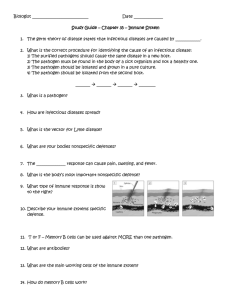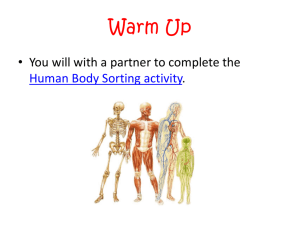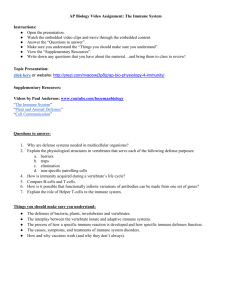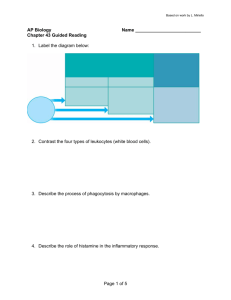Chapter 37 Immune System
advertisement
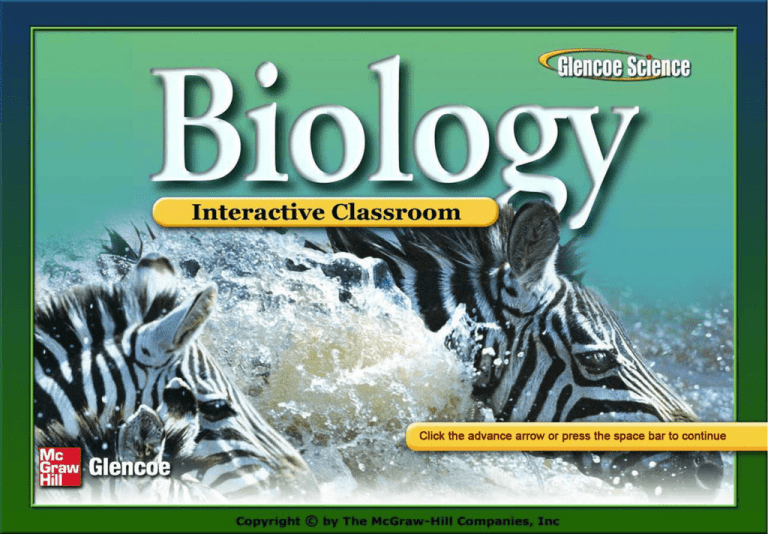
Chapter 37 Immune System Section 1: Infectious Diseases Section 2: The Immune System Section 3: Noninfectious Disorders Click on a lesson name to select. Chapter 37 Immune System 37.1 Infectious Diseases Pathogens Cause Infectious Disease An infectious disease is a disease that is caused when a pathogen is passed from one organism to another. Pathogens are the cause of infectious disease. Bacteria Viruses Protozoans Fungi Parasites Chapter 37 Immune System 37.1 Infectious Diseases Koch’s Postulates Chapter 37 Immune System 37.1 Infectious Diseases Spread of Disease A disease reservoir is a source of the pathogen in the environment. Reservoirs might be animals, people, or inanimate objects, such as soil. Chapter 37 Immune System 37.1 Infectious Diseases Human Reservoirs Humans are the main reservoir for pathogens that affect humans. An individual that is symptom-free but capable of passing the pathogen is called a carrier. Chapter 37 Immune System 37.1 Infectious Diseases Animal Reservoirs Other animals also are reservoirs of pathogens that can be passed to humans. Influenza Rabies Chapter 37 Immune System 37.1 Infectious Diseases Other Reservoirs Soil Contaminated water or food Chapter 37 Immune System 37.1 Infectious Diseases Transmission of Pathogens Direct contact Indirect contact through air Vectors Indirect contact by objects Chapter 37 Immune System 37.1 Infectious Diseases Symptoms of Disease The virus multiplies in the cells and leaves the cells either by exocytosis or by causing the cell to burst. The virus damages tissues and even kills some cells. Harmful chemicals or toxins might be produced. Chapter 37 Immune System 37.1 Infectious Diseases Disease Patterns As outbreaks of diseases spread, certain patterns are observed. The Centers for Disease Control and Prevention (CDC), and the World Health Organization (WHO) monitor disease patterns to help control the spread of diseases. Chapter 37 Immune System 37.1 Infectious Diseases Treating and Fighting Diseases An antibiotic is a substance that can kill or inhibit the growth of other microorganisms. Penicillium Erythromycin Neomycin Gentamicin Chapter 37 Immune System 37.2 The Immune System Nonspecific Immunity The body has a number of defenses in the immune system that fight off pathogens. These defenses are nonspecific because they are not aimed at a specific pathogen. Helps to prevent disease Helps to slow the progression of the disease Chapter 37 Immune System 37.2 The Immune System Skin Barrier Dead skin cells help protect against invasion by microorganisms. Bacteria that live symbiotically on the skin digest skin oils to produce acids that inhibit many pathogens. Chapter 37 Immune System 37.2 The Immune System Chemical Barriers Saliva, tears, and nasal secretions contain the enzyme lysozyme. Lysozyme breaks down bacterial cell walls, which kills pathogens. Mucus acts as a protective barrier, blocking bacteria from sticking to the inner epithelial cells. Chapter 37 Immune System 37.2 The Immune System Nonspecific Responses to Invasion The body has nonspecific immune responses to pathogens that get beyond its barriers. Cellular defense Interferon Inflammatory response Chapter 37 Immune System 37.2 The Immune System Cellular Defense Phagocytosis is the process by which phagocytic cells surround and internalize the foreign microorganisms. The phagocytes release digestive enzymes and other harmful chemicals from their lysosomes, destroying the microorganism. Chapter 37 Immune System 37.2 The Immune System Interferon Virus-infected cells secrete a protein called interferon. Interferon binds to neighboring cells and stimulates these cells to produce antiviral proteins which can prevent viral replication in these cells. Chapter 37 Immune System 37.2 The Immune System Inflammatory Response Increased blood flow to the infected area makes blood vessels more permeable to allow white blood cells to escape into the infected area. Chapter 37 Immune System 37.2 The Immune System Specific Immunity Lymphatic system Organs and cells that filter lymph and blood and destroy foreign microorganisms Chapter 37 Immune System 37.2 The Immune System Lymphatic Organs Lymphatic tissue Lymphocytes Lymphocytes are a type of white blood cell that is produced in red bone marrow. Phagocytosis Neutrophils are the most abundant type of white blood cells in humans, are short lived and initiate inflamation after injury Macrophage sports medicine Chapter 37 Immune System Chapter 37 Immune System 37.2 The Immune System These lymphatic organs include Lymph nodes Tonsils Spleen Thymus gland Diffused lymphatic tissue found in mucous membranes of the intestinal, respiratory, urinary, and genital tracts Chapter 37 Immune System 37.2 The Immune System B Cell Response Antibodies are proteins produced by B lymphocytes that specifically react with a foreign antigen. B lymphocytes, often called B cells, are located in all lymphatic tissues and can be thought of as antibody factories. Visualizing Immune Response Chapter 37 Immune System 37.2 The Immune System B Cell Response The activated helper T cell reproduces, binds processed antigens, and attaches to a B cell. The new helper T cells continue the process of binding antigens, attaching to B cells, and reproducing. Chapter 37 Immune System 37.2 The Immune System B Cell Response Once an activated helper T cell binds to a B cell holding an antigen, the B cell begins to manufacture antibodies that specifically bind to the antigen. The antibodies can enhance the immune response by binding to microorganisms, making them more susceptible to phagocytosis and by initiating the inflammatory response, helping promote the nonspecific response. Chapter 37 Immune System 37.2 The Immune System T Cell Response Helper T cells bind to and activate cytoxic T cells. Activated cytotoxic T cells destroy pathogens and release chemicals called cytokines. Cytokines stimulate the cells of the immune system. Chapter 37 Immune System 37.2 The Immune System Passive Immunity Temporary protection occurs when antibodies are made by other people or animals and are transferred or injected into the body. Chapter 37 Immune System 37.2 The Immune System Active Immunity Active immunity occurs after the immune system is exposed to disease antigens and memory cells are produced. Active immunity can result from having an infectious disease. Immunization is the deliberate exposure of the body to an antigen so a primary response and immune memory cells will develop. Chapter 37 Immune System Chapter 37 Immune System 37.2 The Immune System The secondary response to the antigen has a number of different characteristics. The response is more rapid than the primary response. The overall response, both B and T cell response, is greater during the second exposure. The overall memory lasts longer after the second exposure. Chapter 37 Immune System 37.2 The Immune System Immune System Failure Some diseases can affect the immune system’s effectiveness. Acquired immunodeficiency syndrome (AIDS) HIV infects mainly helper T cells. The helper T cells become HIV factories, producing new viruses. The number of helper T cells in an infected person decreases. Chapter 37 Immune System 37.3 Noninfectious Disorders Genetic Disorders Diseases caused by the inheritance of genes that do not function properly in the body Albinism Sickle cell anemia Huntington disease Hemophilia Chapter 37 Immune System 37.3 Noninfectious Disorders Degenerative Diseases Degenerative diseases are the result of a part of the body wearing out sooner than would be expected in a person’s lifetime. Arthritis Arteriosclerosis Chapter 37 Immune System 37.3 Noninfectious Disorders Metabolic Diseases Metabolic disease results from an error in a biochemical pathway. Type I diabetes Cancer Cancer is characterized by abnormal cell growth. Chapter 37 Immune System 37.3 Noninfectious Disorders Inflammatory Diseases Inflammatory diseases are diseases in which the body produces an inflammatory response to a common substance. Chapter 37 Immune System 37.3 Noninfectious Disorders Allergies Plant pollens Dust Dust mites Various foods Chapter 37 Immune System 37.3 Noninfectious Disorders Chapter 37 Immune System Chapter 37 Immune System 37.3 Noninfectious Disorders Autoimmunity Form antibodies to their own proteins, which injures their cells Rheumatoid arthritis Rheumatic fever Lupus Virtual Pathology Chapter 37 Immune System Chapter Resource Menu Chapter Diagnostic Questions Formative Test Questions Chapter Assessment Questions Standardized Test Practice biologygmh.com Glencoe Biology Transparencies Image Bank Vocabulary Animation Click on a hyperlink to view the corresponding lesson. Chapter 37 Immune System Chapter Diagnostic Questions True or False All bacteria and viruses cause disease. Chapter 37 Immune System Chapter Diagnostic Questions What do Koch’s postulates prove? Chapter 37 Immune System Chapter Diagnostic Questions A. anthrax is harmful to humans B. a specific pathogen causes a specific disease C. pathogens can be grown in the lab D. all bacteria are pathogens Chapter 37 Immune System Chapter Diagnostic Questions West Nile Virus is an example of a disease which is spread by _______. A. direct contact B. indirect contact by objects C. indirect contact through the air D. vectors Chapter 37 Immune System 37.1 Formative Questions Which help keep pathogens from thriving and multiplying on your skin? A. bacteria B. histamines C. natural antibiotics D. red blood cells Chapter 37 Immune System 37.1 Formative Questions What is a disease reservoir? A. the source of a pathogen B. the organ the pathogen infects C. the medium that transmits the pathogen D. the set of symptoms caused by the pathogen Chapter 37 Immune System 37.1 Formative Questions What are the most common vectors that transmit diseases? A. arthropods B. mammals C. chemical toxins D. tiny mucus droplets Chapter 37 Immune System 37.1 Formative Questions What is the source of most antibiotics? A. bacteria B. fungi C. protists D. plants Chapter 37 Immune System 37.2 Formative Questions Which is true of nonspecific immunity? A. It takes time to develop. B. It involves helper T cells. C. It is the first line of defense. D. It is the most effective immune response. Chapter 37 Immune System 37.2 Formative Questions Which substance kills pathogens by breaking down bacterial cell walls? A. cytokine B. hydrochloric acid C. interferon D. lysozyme Chapter 37 Immune System 37.2 Formative Questions How do neutrophils and macrophages defend the body? A. they ingest bacteria B. they produce antibodies C. they recruit lymphocytes D. they secrete cytotokines Chapter 37 Immune System 37.2 Formative Questions Which white blood cells are the antibody factories? A. B cells B. T cells C. cytotoxic T cells D. macrophages Chapter 37 Immune System 37.2 Formative Questions What can be injected into a person that will inactivate the venom from a snakebite or scorpion sting? A. antibodies B. cytokines C. lymphocytes D. macrophages Chapter 37 Immune System 37.3 Formative Questions True or False Noninfectious disorders can have both an environmental and a genetic cause. Chapter 37 Immune System 37.3 Formative Questions What is an abnormal inflammatory response to an environmental antigen that is not pathogenic? A. an allergy B. an autoimmunity C. an anaphylactic reaction D. a metabolic response Chapter 37 Immune System 37.3 Formative Questions What causes anaphylactic shock? A. a large influx of antibodies B. a massive release of histamine C. an extreme autoimmune reaction D. toxic environmental agents Chapter 37 Immune System 37.3 Formative Questions What is the term for the formation of antibodies to the body’s own proteins? A. cancer B. leukemia C. autoimmunity D. antipeptide disorder Chapter 37 Immune System Chapter Assessment Questions Identify the term used to describe a large outbreak of a disease in one area. A. endemic B. epidemic C. pandemic D. systematic Chapter 37 Immune System Chapter Assessment Questions Explain how bacteria become resistant to antibiotics. Answer: If a bacterium contains a trait that enables it to survive when an antibiotic is present, it will reproduce and pass that same survival trait to its offspring. This will create more bacteria also resistant to that antibiotic. Chapter 37 Immune System Chapter Assessment Questions Which lymphatic organ stores blood and destroys damaged blood cells? A. lymph nodes B. tonsils C. spleen D. thymus Chapter 37 Immune System Standardized Test Practice Which provides the strongest evidence that a specific pathogen has been identified as the disease agent? Chapter 37 Immune System Standardized Test Practice A. Host B also dies of the disease. B. Host B shows similar symptoms as host A. C. Culture B shows characteristics of a known pathogen. D. Culture B shows the same characteristic as Culture A. Chapter 37 Immune System Standardized Test Practice How are most viral diseases fought? A. with antibiotics B. with antiviral drugs C. with chemical agents D. by the body’s immune system Chapter 37 Immune System Standardized Test Practice What is the most likely reason for bacterial resistance to the antibiotic penicillin? A. The bacteria have been grown in pure culture media. B. The bacteria have weakened the affects of penicillin. Chapter 37 Immune System Standardized Test Practice What is the most likely reason for bacterial resistance to the antibiotic penicillin? C. The human population has doubled in the last 30 years. D. Penicillin has been used to treat bacterial infections since World War II. Chapter 37 Immune System Standardized Test Practice What is the main cause of aches and pains associated with the flu? A. The pathogen affects the nervous system. B. The pathogen invades and lives inside cells. C. The pathogen produces chemical toxins. D. The pathogen triggers an immune response. Chapter 37 Immune System Standardized Test Practice Which term best describes the function of interferon? A. antigenator B. messenger C. supporter D. virus-killer Chapter 37 Immune System Standardized Test Practice What is the purpose of immunization? A. to desensitize the immune system B. to cause memory cells to develop C. to destroy competing pathogens D. to stimulate interferon production Chapter 37 Immune System Standardized Test Practice What enables the secondary response to the antigen to be more rapid and stronger than the primary response to the antigen? Chapter 37 Immune System Standardized Test Practice A. activated T cells B. antihistamines C. memory B cells D. secondary antibodies Chapter 37 Immune System Glencoe Biology Transparencies Chapter 37 Immune System Image Bank Chapter 37 Immune System Vocabulary Section 1 infectious disease pandemic pathogen antibiotic Koch’s postulates reservoir endemic disease epidemic Chapter 37 Immune System Vocabulary Section 2 complement protein memory cell interferon immunization lymphocyte antibody B cell helper T cell cytotoxic T cell Chapter 37 Immune System Vocabulary Section 3 degenerative disease metabolic disease allergy anaphylactic shock Chapter 37 Immune System Animation Visualizing Immune Response


